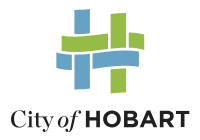City of Hobart
Workers place of residence by industry - All industries
Journey to Work (workers) data shows where the City of Hobart's local workers come from and how far they are travelling to access employment in the area.
This shows the degree to which the local economy draws on the wider region to supply labour for its industries. It is also useful in planning and advocacy for roads and public transport provision.
The distance and direction travelled by workers in different industry sectors may be influenced by the nature of employment opportunities (higher paid, high value employment may draw people from a wider area); the skill level required (jobs requiring tertiary qualifications will draw more workers from areas with high qualification levels among the residents) the number of jobs available in the industry sector (sectors with more opportunities may have a wider catchment); transport options available and commuting times to the City of Hobart.
Workers place of residence data should be viewed alongside Self-sufficiency and Jobs to workers ratio datasets for a summary of local employment opportunity by industry, as well as modelled Employment by industry (Total) numbers and Employment locations to understand the relative size of each industry sector and its distribution across the City of Hobart. To analyse the characteristics of local workers in each industry, go to the Local workers section.
Data source
Australian Bureau of Statistics (ABS) – Census 2021 – by journey to work
Select industry:
| Residential location of local workers by industry | |||||||||
|---|---|---|---|---|---|---|---|---|---|
| City of Hobart - All industries | 2021 | ||||||||
| Location | Number | % | |||||||
| Live and work in the area | 20,111 | 34.9 | |||||||
| Work in the area, but live outside | 37,566 | 65.1 | |||||||
| Total workers in the area | 57,677 | 100.0 | |||||||
Source: Australian Bureau of Statistics, Census of Population and Housing 2021. Compiled and presented in economy.id by .id (informed decisions) Excludes residential locations with fewer than 10 people. | |||||||||

| Residential location of local workers by LGA by industry | |||||||||
|---|---|---|---|---|---|---|---|---|---|
| City of Hobart - All industries | 2021 | ||||||||
| Location | Number | % | |||||||
| Hobart | 20,111 | 34.9 | |||||||
| Clarence | 11,693 | 20.3 | |||||||
| Glenorchy | 9,271 | 16.1 | |||||||
| Kingborough | 8,102 | 14.0 | |||||||
| Brighton | 2,289 | 4.0 | |||||||
| Sorell | 2,088 | 3.6 | |||||||
| Huon Valley | 1,442 | 2.5 | |||||||
| Derwent Valley | 897 | 1.6 | |||||||
| Southern Midlands | 461 | 0.8 | |||||||
| Launceston | 199 | 0.3 | |||||||
| Glamorgan-Spring Bay | 90 | 0.2 | |||||||
| Tasman | 70 | 0.1 | |||||||
| Central Highlands (Tas.) | 68 | 0.1 | |||||||
| West Tamar | 58 | 0.1 | |||||||
| No usual address (Tas.) | 52 | 0.1 | |||||||
| Brisbane | 50 | 0.1 | |||||||
| Central Coast (Tas.) | 37 | 0.1 | |||||||
| Devonport | 37 | 0.1 | |||||||
| Meander Valley | 36 | 0.1 | |||||||
| Northern Midlands | 25 | 0.0 | |||||||
| Gold Coast | 25 | 0.0 | |||||||
| Unincorporated ACT | 21 | 0.0 | |||||||
| Burnie | 20 | 0.0 | |||||||
| Melbourne | 19 | 0.0 | |||||||
| Yarra | 19 | 0.0 | |||||||
| Latrobe (Tas.) | 19 | 0.0 | |||||||
| Boroondara | 16 | 0.0 | |||||||
| Break O'Day | 16 | 0.0 | |||||||
| Moreton Bay | 16 | 0.0 | |||||||
| Kentish | 15 | 0.0 | |||||||
| Greater Geelong | 14 | 0.0 | |||||||
| Port Phillip | 13 | 0.0 | |||||||
| Stonnington | 11 | 0.0 | |||||||
| Darebin | 11 | 0.0 | |||||||
| Sunshine Coast | 11 | 0.0 | |||||||
| Cairns | 10 | 0.0 | |||||||
| Wyndham | 10 | 0.0 | |||||||
| Waratah-Wynyard | 10 | 0.0 | |||||||
Source: Australian Bureau of Statistics, Census of Population and Housing 2021. Compiled and presented in economy.id by .id (informed decisions) Excludes residential locations with fewer than 10 people. | |||||||||
